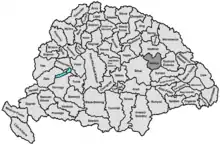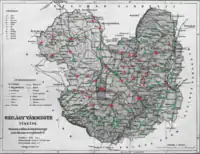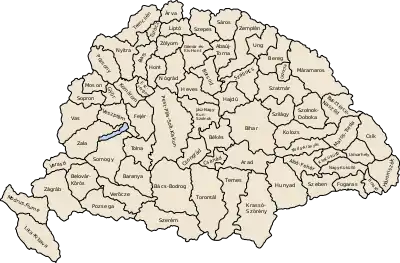Szilágy County
Szilágy (Romanian: Sălaj) was an administrative county (comitatus) of the Kingdom of Hungary. Its territory is now in north-western Romania. The capital of the county was Zilah (present-day Zalău in Romania).
| Szilágy County | |
|---|---|
| County of the Kingdom of Hungary (1876-1920, 1940-1945) | |
 Coat of arms
| |
 | |
| Capital | Zilah |
| Area | |
| • Coordinates | 47°11′N 23°3′E |
• 1910 | 3,815 km2 (1,473 sq mi) |
| Population | |
• 1910 | 230100 |
| History | |
• Established | 1876 |
• Treaty of Trianon | 4 June 1920 |
• County recreated (Second Vienna Award) | 30 August 1940 |
• Disestablished | 1945 |
| Today part of | |
| Zalău is the current name of the capital. | |
Geography
Szilágy county shared borders with the Hungarian counties Bihar, Szatmár, Szolnok-Doboka and Kolozs. The rivers Szamos and Kraszna flow through the county. Its territory is for a large part the same as that of the present Romanian county Sălaj. Its area was 3815 km2 around 1910.
History
Szilágy county was formed in 1876, when the counties of Kraszna (Its center was Valkóváralja at first, later Szilágysomlyó), Közép-Szolnok (Its center was Zilah) and the Egregy district of Doboka County were united.
In 1920 by the Treaty of Trianon the county became part of Romania. It was returned to Hungary by the Second Vienna Award in 1940, with a slightly modified territory. After World War II it became the part again of Romania. Most of it is now part of the Romanian county Sălaj, except some areas in the north-west (now in Satu Mare county) and north-east (now in Maramureş county).
Demographics
In 1900, the county had a population of 207,293 people and was composed of the following linguistic communities:[1]
Total:
- Romanian: 125,451 (60.5%)
- Hungarian: 76,482 (36.9%)
- Slovak: 2,873 (1.4%)
- German: 1,494 (0.7%)
- Ruthenian: 46 (0.0%)
- Croatian: 6 (0.0%)
- Serbian: 4 (0.0%)
- Other or unknown: 937 (0.5%)
According to the census of 1900, the county was composed of the following religious communities:[2]
Total:
- Greek Catholic: 120,544 (58.2%)
- Calvinist: 55,952 (27.0%)
- Roman Catholic: 13,243 (6.4%)
- Jewish: 8,887(4.3%)
- Eastern Orthodox: 7,902 (3.8%)
- Lutheran: 686 (0.3%)
- Unitarian: 74 (0.0%)
- Other or unknown: 5 (0.0%)

In 1910, county had a population of 230,140 people and was composed of the following linguistic communities:[3]
Total:
- Romanian: 136,087 (59.1%)
- Hungarian: 87,312 (37.9%)
- Slovak: 3,727 (1.6%)
- German: 816 (0.4%)
- Ruthenian: 52 (0.0%)
- Serbian: 6 (0.0%)
- Croatian: 5 (0.0%)
- Other or unknown: 2,135 (0.9%)
According to the census of 1910, the county was composed of the following religious communities:[4]
Total:
- Greek Catholic: 132,741 (57.7%)
- Calvinist: 60,938 (26.5%)
- Roman Catholic: 15,569 (6.8%)
- Jewish: 9,849 (4.3%)
- Eastern Orthodox: 9,801 (4.3%)
- Lutheran: 786 (0.3%)
- Unitarianist: 77 (0.0%)
- Other or unknown: 379 (0.1%)
Subdivisions
In the early 20th century, the subdivisions of Szilágy county were:
| Districts (járás) | |
|---|---|
| District | Capital |
| Kraszna | Kraszna, RO Crasna |
| Szilágycseh | Szilágycseh, RO Cehu Silvaniei |
| Szilágysomlyó | Szilágysomlyó, RO Șimleu Silvaniei |
| Tasnád | Tasnád, RO Tăşnad |
| Zilah | Zilah, RO Zalău |
| Zsibó | Zsibó, RO Jibou |
| Urban districts (rendezett tanácsú város) | |
| Szilágysomlyó, RO Șimleu Silvaniei | |
| Zilah, RO Zalău | |
See also
- Szilágyi surname
References
- "KlimoTheca :: Könyvtár". Kt.lib.pte.hu. Retrieved 6 December 2012.
- "KlimoTheca :: Könyvtár". Kt.lib.pte.hu. Retrieved 6 December 2012.
- "KlimoTheca :: Könyvtár". Kt.lib.pte.hu. Retrieved 19 June 2012.
- "KlimoTheca :: Könyvtár". Kt.lib.pte.hu. Retrieved 19 June 2012.
